 China: The Soong Sisters, Ailing, Meiling and Qingling Soong (in black) visiting Nationlist women soldiers, 1940s. The Soong Sisters (Songjia Jiemei, or 'Song Household Sisters') were three Hakka Chinese women who were, along with their husbands, among China's most significant political figures of the 20th century. They each played a major role in influencing their husbands, which, along with their own positions of power, ultimately changed the course of Chinese history. Stock Photohttps://www.alamy.com/licenses-and-pricing/?v=1https://www.alamy.com/china-the-soong-sisters-ailing-meiling-and-qingling-soong-in-black-visiting-nationlist-women-soldiers-1940s-the-soong-sisters-songjia-jiemei-or-song-household-sisters-were-three-hakka-chinese-women-who-were-along-with-their-husbands-among-chinas-most-significant-political-figures-of-the-20th-century-they-each-played-a-major-role-in-influencing-their-husbands-which-along-with-their-own-positions-of-power-ultimately-changed-the-course-of-chinese-history-image344231279.html
China: The Soong Sisters, Ailing, Meiling and Qingling Soong (in black) visiting Nationlist women soldiers, 1940s. The Soong Sisters (Songjia Jiemei, or 'Song Household Sisters') were three Hakka Chinese women who were, along with their husbands, among China's most significant political figures of the 20th century. They each played a major role in influencing their husbands, which, along with their own positions of power, ultimately changed the course of Chinese history. Stock Photohttps://www.alamy.com/licenses-and-pricing/?v=1https://www.alamy.com/china-the-soong-sisters-ailing-meiling-and-qingling-soong-in-black-visiting-nationlist-women-soldiers-1940s-the-soong-sisters-songjia-jiemei-or-song-household-sisters-were-three-hakka-chinese-women-who-were-along-with-their-husbands-among-chinas-most-significant-political-figures-of-the-20th-century-they-each-played-a-major-role-in-influencing-their-husbands-which-along-with-their-own-positions-of-power-ultimately-changed-the-course-of-chinese-history-image344231279.htmlRM2B012E7–China: The Soong Sisters, Ailing, Meiling and Qingling Soong (in black) visiting Nationlist women soldiers, 1940s. The Soong Sisters (Songjia Jiemei, or 'Song Household Sisters') were three Hakka Chinese women who were, along with their husbands, among China's most significant political figures of the 20th century. They each played a major role in influencing their husbands, which, along with their own positions of power, ultimately changed the course of Chinese history.
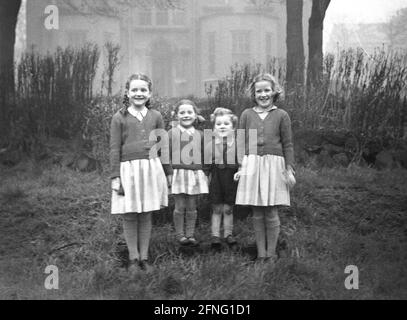 1950s, historica, family picture, big smiles alround as three sisters, in their school clothes stand with their little brother, for a photo, England, UK. Stock Photohttps://www.alamy.com/licenses-and-pricing/?v=1https://www.alamy.com/1950s-historica-family-picture-big-smiles-alround-as-three-sisters-in-their-school-clothes-stand-with-their-little-brother-for-a-photo-england-uk-image426308989.html
1950s, historica, family picture, big smiles alround as three sisters, in their school clothes stand with their little brother, for a photo, England, UK. Stock Photohttps://www.alamy.com/licenses-and-pricing/?v=1https://www.alamy.com/1950s-historica-family-picture-big-smiles-alround-as-three-sisters-in-their-school-clothes-stand-with-their-little-brother-for-a-photo-england-uk-image426308989.htmlRM2FNG1D1–1950s, historica, family picture, big smiles alround as three sisters, in their school clothes stand with their little brother, for a photo, England, UK.
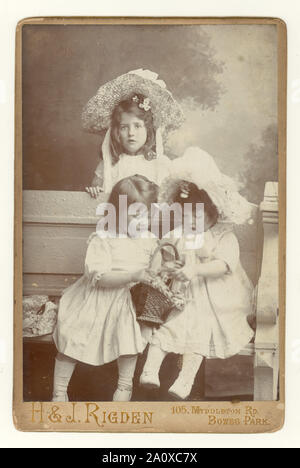 Original antique Edwardian cabinet card, charming studio portrait of three pretty young siblings, sisters, in summer clothes, wearing large straw hats and white smocks, From the studio of Herbert and James Rigden, Bowes Park, London, U.K. circa 1904. Stock Photohttps://www.alamy.com/licenses-and-pricing/?v=1https://www.alamy.com/original-antique-edwardian-cabinet-card-charming-studio-portrait-of-three-pretty-young-siblings-sisters-in-summer-clothes-wearing-large-straw-hats-and-white-smocks-from-the-studio-of-herbert-and-james-rigden-bowes-park-london-uk-circa-1904-image327577374.html
Original antique Edwardian cabinet card, charming studio portrait of three pretty young siblings, sisters, in summer clothes, wearing large straw hats and white smocks, From the studio of Herbert and James Rigden, Bowes Park, London, U.K. circa 1904. Stock Photohttps://www.alamy.com/licenses-and-pricing/?v=1https://www.alamy.com/original-antique-edwardian-cabinet-card-charming-studio-portrait-of-three-pretty-young-siblings-sisters-in-summer-clothes-wearing-large-straw-hats-and-white-smocks-from-the-studio-of-herbert-and-james-rigden-bowes-park-london-uk-circa-1904-image327577374.htmlRM2A0XC7X–Original antique Edwardian cabinet card, charming studio portrait of three pretty young siblings, sisters, in summer clothes, wearing large straw hats and white smocks, From the studio of Herbert and James Rigden, Bowes Park, London, U.K. circa 1904.
 1961, historical, three girls, sisters, standing for a photo in the walled back garden of a victorian terraced house, Stockport, Manchester, England, UK. A metal bucket of the era, with lid can be seen. Stock Photohttps://www.alamy.com/licenses-and-pricing/?v=1https://www.alamy.com/1961-historical-three-girls-sisters-standing-for-a-photo-in-the-walled-back-garden-of-a-victorian-terraced-house-stockport-manchester-england-uk-a-metal-bucket-of-the-era-with-lid-can-be-seen-image466815519.html
1961, historical, three girls, sisters, standing for a photo in the walled back garden of a victorian terraced house, Stockport, Manchester, England, UK. A metal bucket of the era, with lid can be seen. Stock Photohttps://www.alamy.com/licenses-and-pricing/?v=1https://www.alamy.com/1961-historical-three-girls-sisters-standing-for-a-photo-in-the-walled-back-garden-of-a-victorian-terraced-house-stockport-manchester-england-uk-a-metal-bucket-of-the-era-with-lid-can-be-seen-image466815519.htmlRM2J3D7XR–1961, historical, three girls, sisters, standing for a photo in the walled back garden of a victorian terraced house, Stockport, Manchester, England, UK. A metal bucket of the era, with lid can be seen.
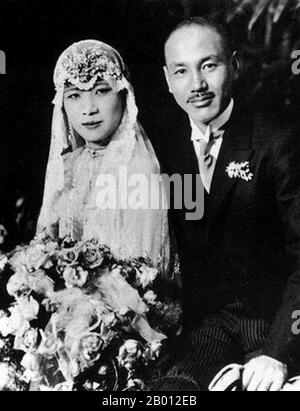 China/Taiwan: Soong May-ling (Song Meiling, 1898-2003), at her marriage to Chiang Kai-shek, Shanghai, 1 December, 1927. Soong May-ling or Mei-ling, also known as Madame Chiang Kai-shek (Song Meiling, 1898-2003), First Lady of the Republic of China (ROC) and wife of President Chiang Kai-shek. She was a politician and painter. The youngest and the last surviving of the three Soong sisters, she played a prominent role in the politics of the Republic of China and was the sister of Song Qingling, wife of President Sun Yat-sen, the founder of the Chinese Republic (1912). Stock Photohttps://www.alamy.com/licenses-and-pricing/?v=1https://www.alamy.com/chinataiwan-soong-may-ling-song-meiling-1898-2003-at-her-marriage-to-chiang-kai-shek-shanghai-1-december-1927-soong-may-ling-or-mei-ling-also-known-as-madame-chiang-kai-shek-song-meiling-1898-2003-first-lady-of-the-republic-of-china-roc-and-wife-of-president-chiang-kai-shek-she-was-a-politician-and-painter-the-youngest-and-the-last-surviving-of-the-three-soong-sisters-she-played-a-prominent-role-in-the-politics-of-the-republic-of-china-and-was-the-sister-of-song-qingling-wife-of-president-sun-yat-sen-the-founder-of-the-chinese-republic-1912-image344231283.html
China/Taiwan: Soong May-ling (Song Meiling, 1898-2003), at her marriage to Chiang Kai-shek, Shanghai, 1 December, 1927. Soong May-ling or Mei-ling, also known as Madame Chiang Kai-shek (Song Meiling, 1898-2003), First Lady of the Republic of China (ROC) and wife of President Chiang Kai-shek. She was a politician and painter. The youngest and the last surviving of the three Soong sisters, she played a prominent role in the politics of the Republic of China and was the sister of Song Qingling, wife of President Sun Yat-sen, the founder of the Chinese Republic (1912). Stock Photohttps://www.alamy.com/licenses-and-pricing/?v=1https://www.alamy.com/chinataiwan-soong-may-ling-song-meiling-1898-2003-at-her-marriage-to-chiang-kai-shek-shanghai-1-december-1927-soong-may-ling-or-mei-ling-also-known-as-madame-chiang-kai-shek-song-meiling-1898-2003-first-lady-of-the-republic-of-china-roc-and-wife-of-president-chiang-kai-shek-she-was-a-politician-and-painter-the-youngest-and-the-last-surviving-of-the-three-soong-sisters-she-played-a-prominent-role-in-the-politics-of-the-republic-of-china-and-was-the-sister-of-song-qingling-wife-of-president-sun-yat-sen-the-founder-of-the-chinese-republic-1912-image344231283.htmlRM2B012EB–China/Taiwan: Soong May-ling (Song Meiling, 1898-2003), at her marriage to Chiang Kai-shek, Shanghai, 1 December, 1927. Soong May-ling or Mei-ling, also known as Madame Chiang Kai-shek (Song Meiling, 1898-2003), First Lady of the Republic of China (ROC) and wife of President Chiang Kai-shek. She was a politician and painter. The youngest and the last surviving of the three Soong sisters, she played a prominent role in the politics of the Republic of China and was the sister of Song Qingling, wife of President Sun Yat-sen, the founder of the Chinese Republic (1912).
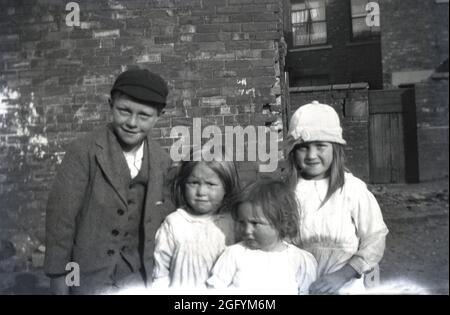 1920s, historical, a young boy wearing a wool suit and hat, with his three little sisters, standing together outside in a victorian back-street, for a photo, England, UK. Stock Photohttps://www.alamy.com/licenses-and-pricing/?v=1https://www.alamy.com/1920s-historical-a-young-boy-wearing-a-wool-suit-and-hat-with-his-three-little-sisters-standing-together-outside-in-a-victorian-back-street-for-a-photo-england-uk-image440087612.html
1920s, historical, a young boy wearing a wool suit and hat, with his three little sisters, standing together outside in a victorian back-street, for a photo, England, UK. Stock Photohttps://www.alamy.com/licenses-and-pricing/?v=1https://www.alamy.com/1920s-historical-a-young-boy-wearing-a-wool-suit-and-hat-with-his-three-little-sisters-standing-together-outside-in-a-victorian-back-street-for-a-photo-england-uk-image440087612.htmlRM2GFYM6M–1920s, historical, a young boy wearing a wool suit and hat, with his three little sisters, standing together outside in a victorian back-street, for a photo, England, UK.
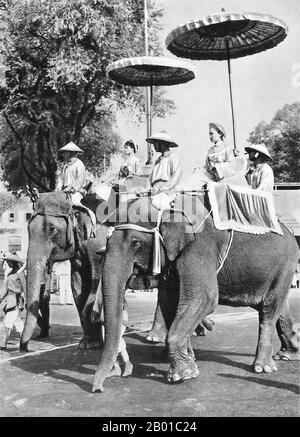 Vietnam: The Trung Sisters (Hai Ba Trung) Parade in Saigon, 26 April 1957. Two Vietnamese women on elephant back represent the celebrated Trung Sisters (Hai Ba Trung) in the annual Hai Ba Trung Parade, Saigon, 26 April 1957. The Trưng Sisters (c. 12-43 CE), known in Vietnamese as Hai Bà Trưng (literally 'the two Trưng Ladies'), and individually as Trưng Trắc and Trưng Nhị, were two first century Vietnamese women leaders from North Vietnam who successfully rebelled against Chinese Han Dynasty rule for three years, and are regarded as national heroines of Vietnam. Stock Photohttps://www.alamy.com/licenses-and-pricing/?v=1https://www.alamy.com/vietnam-the-trung-sisters-hai-ba-trung-parade-in-saigon-26-april-1957-two-vietnamese-women-on-elephant-back-represent-the-celebrated-trung-sisters-hai-ba-trung-in-the-annual-hai-ba-trung-parade-saigon-26-april-1957-the-trng-sisters-c-12-43-ce-known-in-vietnamese-as-hai-b-trng-literally-the-two-trng-ladies-and-individually-as-trng-trc-and-trng-nh-were-two-first-century-vietnamese-women-leaders-from-north-vietnam-who-successfully-rebelled-against-chinese-han-dynasty-rule-for-three-years-and-are-regarded-as-national-heroines-of-vietnam-image344238780.html
Vietnam: The Trung Sisters (Hai Ba Trung) Parade in Saigon, 26 April 1957. Two Vietnamese women on elephant back represent the celebrated Trung Sisters (Hai Ba Trung) in the annual Hai Ba Trung Parade, Saigon, 26 April 1957. The Trưng Sisters (c. 12-43 CE), known in Vietnamese as Hai Bà Trưng (literally 'the two Trưng Ladies'), and individually as Trưng Trắc and Trưng Nhị, were two first century Vietnamese women leaders from North Vietnam who successfully rebelled against Chinese Han Dynasty rule for three years, and are regarded as national heroines of Vietnam. Stock Photohttps://www.alamy.com/licenses-and-pricing/?v=1https://www.alamy.com/vietnam-the-trung-sisters-hai-ba-trung-parade-in-saigon-26-april-1957-two-vietnamese-women-on-elephant-back-represent-the-celebrated-trung-sisters-hai-ba-trung-in-the-annual-hai-ba-trung-parade-saigon-26-april-1957-the-trng-sisters-c-12-43-ce-known-in-vietnamese-as-hai-b-trng-literally-the-two-trng-ladies-and-individually-as-trng-trc-and-trng-nh-were-two-first-century-vietnamese-women-leaders-from-north-vietnam-who-successfully-rebelled-against-chinese-han-dynasty-rule-for-three-years-and-are-regarded-as-national-heroines-of-vietnam-image344238780.htmlRM2B01C24–Vietnam: The Trung Sisters (Hai Ba Trung) Parade in Saigon, 26 April 1957. Two Vietnamese women on elephant back represent the celebrated Trung Sisters (Hai Ba Trung) in the annual Hai Ba Trung Parade, Saigon, 26 April 1957. The Trưng Sisters (c. 12-43 CE), known in Vietnamese as Hai Bà Trưng (literally 'the two Trưng Ladies'), and individually as Trưng Trắc and Trưng Nhị, were two first century Vietnamese women leaders from North Vietnam who successfully rebelled against Chinese Han Dynasty rule for three years, and are regarded as national heroines of Vietnam.
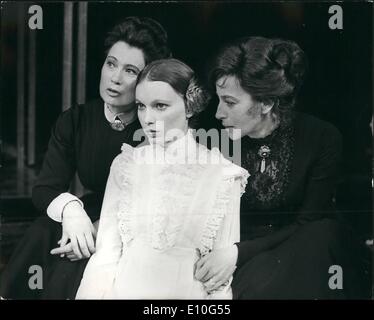 Jan. 01, 1973 - Rehearsing for ''The Three sisters'': There was a rehearsal today for ''The Three Sisters'' , the first 'Company Theater' production at Greenwich Theater, where it opens on Thursday, January 25. Photo shows pictured during today's dress rehearsal at the Greenwich Theater are (L to R): Joy Parker as Olga; Mia Farrow Chekhov's ''The Three Sisters' Stock Photohttps://www.alamy.com/licenses-and-pricing/?v=1https://www.alamy.com/jan-01-1973-rehearsing-for-the-three-sisters-there-was-a-rehearsal-image69468817.html
Jan. 01, 1973 - Rehearsing for ''The Three sisters'': There was a rehearsal today for ''The Three Sisters'' , the first 'Company Theater' production at Greenwich Theater, where it opens on Thursday, January 25. Photo shows pictured during today's dress rehearsal at the Greenwich Theater are (L to R): Joy Parker as Olga; Mia Farrow Chekhov's ''The Three Sisters' Stock Photohttps://www.alamy.com/licenses-and-pricing/?v=1https://www.alamy.com/jan-01-1973-rehearsing-for-the-three-sisters-there-was-a-rehearsal-image69468817.htmlRME10G55–Jan. 01, 1973 - Rehearsing for ''The Three sisters'': There was a rehearsal today for ''The Three Sisters'' , the first 'Company Theater' production at Greenwich Theater, where it opens on Thursday, January 25. Photo shows pictured during today's dress rehearsal at the Greenwich Theater are (L to R): Joy Parker as Olga; Mia Farrow Chekhov's ''The Three Sisters'
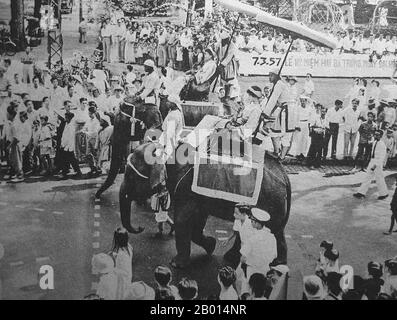 Vietnam: The Trung Sisters (Hai Ba Trung) Parade in Saigon, 26 April, 1957. Two Vietnamese women on elephant back represent the celebrated Trung Sisters (Hai Ba Trung) in the annual Hai Ba Trung Parade, Saigon, 26 April 1957. The Trưng Sisters (c. 12 - 43 CE), known in Vietnamese as Hai Bà Trưng (literally 'the two Trưng Ladies'), and individually as Trưng Trắc and Trưng Nhị, were two first century Vietnamese women leaders who successfully rebelled against Chinese Han-Dynasty rule for three years, and are regarded as national heroines of Vietnam. Stock Photohttps://www.alamy.com/licenses-and-pricing/?v=1https://www.alamy.com/vietnam-the-trung-sisters-hai-ba-trung-parade-in-saigon-26-april-1957-two-vietnamese-women-on-elephant-back-represent-the-celebrated-trung-sisters-hai-ba-trung-in-the-annual-hai-ba-trung-parade-saigon-26-april-1957-the-trng-sisters-c-12-43-ce-known-in-vietnamese-as-hai-b-trng-literally-the-two-trng-ladies-and-individually-as-trng-trc-and-trng-nh-were-two-first-century-vietnamese-women-leaders-who-successfully-rebelled-against-chinese-han-dynasty-rule-for-three-years-and-are-regarded-as-national-heroines-of-vietnam-image344233059.html
Vietnam: The Trung Sisters (Hai Ba Trung) Parade in Saigon, 26 April, 1957. Two Vietnamese women on elephant back represent the celebrated Trung Sisters (Hai Ba Trung) in the annual Hai Ba Trung Parade, Saigon, 26 April 1957. The Trưng Sisters (c. 12 - 43 CE), known in Vietnamese as Hai Bà Trưng (literally 'the two Trưng Ladies'), and individually as Trưng Trắc and Trưng Nhị, were two first century Vietnamese women leaders who successfully rebelled against Chinese Han-Dynasty rule for three years, and are regarded as national heroines of Vietnam. Stock Photohttps://www.alamy.com/licenses-and-pricing/?v=1https://www.alamy.com/vietnam-the-trung-sisters-hai-ba-trung-parade-in-saigon-26-april-1957-two-vietnamese-women-on-elephant-back-represent-the-celebrated-trung-sisters-hai-ba-trung-in-the-annual-hai-ba-trung-parade-saigon-26-april-1957-the-trng-sisters-c-12-43-ce-known-in-vietnamese-as-hai-b-trng-literally-the-two-trng-ladies-and-individually-as-trng-trc-and-trng-nh-were-two-first-century-vietnamese-women-leaders-who-successfully-rebelled-against-chinese-han-dynasty-rule-for-three-years-and-are-regarded-as-national-heroines-of-vietnam-image344233059.htmlRM2B014NR–Vietnam: The Trung Sisters (Hai Ba Trung) Parade in Saigon, 26 April, 1957. Two Vietnamese women on elephant back represent the celebrated Trung Sisters (Hai Ba Trung) in the annual Hai Ba Trung Parade, Saigon, 26 April 1957. The Trưng Sisters (c. 12 - 43 CE), known in Vietnamese as Hai Bà Trưng (literally 'the two Trưng Ladies'), and individually as Trưng Trắc and Trưng Nhị, were two first century Vietnamese women leaders who successfully rebelled against Chinese Han-Dynasty rule for three years, and are regarded as national heroines of Vietnam.
![Kings Zog's three sisters in Vienna. Beauties of modern Albania. The three beautiful sisters of King Zog of Albania [born Ahmet Muhtar Bej Zogolli] are paying a visit to Vienna, where they are displaying great interest in the museums and art galleries. The princesses reflect their brother's modern ideas and are smartly attired in the latest creations of the big Capitals. Photo shows: the three sisters of King Zog photographed at the Museum of Ethnology in Vienna. 29 April 1937 Stock Photo Kings Zog's three sisters in Vienna. Beauties of modern Albania. The three beautiful sisters of King Zog of Albania [born Ahmet Muhtar Bej Zogolli] are paying a visit to Vienna, where they are displaying great interest in the museums and art galleries. The princesses reflect their brother's modern ideas and are smartly attired in the latest creations of the big Capitals. Photo shows: the three sisters of King Zog photographed at the Museum of Ethnology in Vienna. 29 April 1937 Stock Photo](https://l450v.alamy.com/450v/2bw1y14/kings-zogs-three-sisters-in-vienna-beauties-of-modern-albania-the-three-beautiful-sisters-of-king-zog-of-albania-born-ahmet-muhtar-bej-zogolli-are-paying-a-visit-to-vienna-where-they-are-displaying-great-interest-in-the-museums-and-art-galleries-the-princesses-reflect-their-brothers-modern-ideas-and-are-smartly-attired-in-the-latest-creations-of-the-big-capitals-photo-shows-the-three-sisters-of-king-zog-photographed-at-the-museum-of-ethnology-in-vienna-29-april-1937-2bw1y14.jpg) Kings Zog's three sisters in Vienna. Beauties of modern Albania. The three beautiful sisters of King Zog of Albania [born Ahmet Muhtar Bej Zogolli] are paying a visit to Vienna, where they are displaying great interest in the museums and art galleries. The princesses reflect their brother's modern ideas and are smartly attired in the latest creations of the big Capitals. Photo shows: the three sisters of King Zog photographed at the Museum of Ethnology in Vienna. 29 April 1937 Stock Photohttps://www.alamy.com/licenses-and-pricing/?v=1https://www.alamy.com/kings-zogs-three-sisters-in-vienna-beauties-of-modern-albania-the-three-beautiful-sisters-of-king-zog-of-albania-born-ahmet-muhtar-bej-zogolli-are-paying-a-visit-to-vienna-where-they-are-displaying-great-interest-in-the-museums-and-art-galleries-the-princesses-reflect-their-brothers-modern-ideas-and-are-smartly-attired-in-the-latest-creations-of-the-big-capitals-photo-shows-the-three-sisters-of-king-zog-photographed-at-the-museum-of-ethnology-in-vienna-29-april-1937-image359616912.html
Kings Zog's three sisters in Vienna. Beauties of modern Albania. The three beautiful sisters of King Zog of Albania [born Ahmet Muhtar Bej Zogolli] are paying a visit to Vienna, where they are displaying great interest in the museums and art galleries. The princesses reflect their brother's modern ideas and are smartly attired in the latest creations of the big Capitals. Photo shows: the three sisters of King Zog photographed at the Museum of Ethnology in Vienna. 29 April 1937 Stock Photohttps://www.alamy.com/licenses-and-pricing/?v=1https://www.alamy.com/kings-zogs-three-sisters-in-vienna-beauties-of-modern-albania-the-three-beautiful-sisters-of-king-zog-of-albania-born-ahmet-muhtar-bej-zogolli-are-paying-a-visit-to-vienna-where-they-are-displaying-great-interest-in-the-museums-and-art-galleries-the-princesses-reflect-their-brothers-modern-ideas-and-are-smartly-attired-in-the-latest-creations-of-the-big-capitals-photo-shows-the-three-sisters-of-king-zog-photographed-at-the-museum-of-ethnology-in-vienna-29-april-1937-image359616912.htmlRM2BW1Y14–Kings Zog's three sisters in Vienna. Beauties of modern Albania. The three beautiful sisters of King Zog of Albania [born Ahmet Muhtar Bej Zogolli] are paying a visit to Vienna, where they are displaying great interest in the museums and art galleries. The princesses reflect their brother's modern ideas and are smartly attired in the latest creations of the big Capitals. Photo shows: the three sisters of King Zog photographed at the Museum of Ethnology in Vienna. 29 April 1937
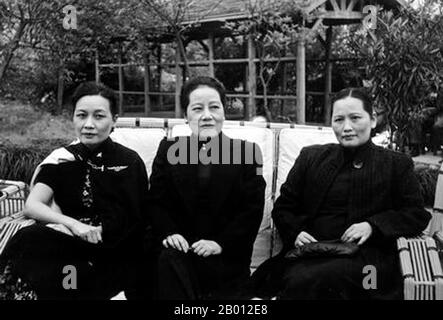 China: The Soong Sisters, Meiling, Ailing and Qingling Soong, Chongqing, 1942. The Soong Sisters (Songjia Jiemei, or 'Song Household Sisters') were three Hakka Chinese women who were, along with their husbands, among China's most significant political figures of the 20th century. They each played a major role in influencing their husbands, which, along with their own positions of power, ultimately changed the course of Chinese history. Stock Photohttps://www.alamy.com/licenses-and-pricing/?v=1https://www.alamy.com/china-the-soong-sisters-meiling-ailing-and-qingling-soong-chongqing-1942-the-soong-sisters-songjia-jiemei-or-song-household-sisters-were-three-hakka-chinese-women-who-were-along-with-their-husbands-among-chinas-most-significant-political-figures-of-the-20th-century-they-each-played-a-major-role-in-influencing-their-husbands-which-along-with-their-own-positions-of-power-ultimately-changed-the-course-of-chinese-history-image344231280.html
China: The Soong Sisters, Meiling, Ailing and Qingling Soong, Chongqing, 1942. The Soong Sisters (Songjia Jiemei, or 'Song Household Sisters') were three Hakka Chinese women who were, along with their husbands, among China's most significant political figures of the 20th century. They each played a major role in influencing their husbands, which, along with their own positions of power, ultimately changed the course of Chinese history. Stock Photohttps://www.alamy.com/licenses-and-pricing/?v=1https://www.alamy.com/china-the-soong-sisters-meiling-ailing-and-qingling-soong-chongqing-1942-the-soong-sisters-songjia-jiemei-or-song-household-sisters-were-three-hakka-chinese-women-who-were-along-with-their-husbands-among-chinas-most-significant-political-figures-of-the-20th-century-they-each-played-a-major-role-in-influencing-their-husbands-which-along-with-their-own-positions-of-power-ultimately-changed-the-course-of-chinese-history-image344231280.htmlRM2B012E8–China: The Soong Sisters, Meiling, Ailing and Qingling Soong, Chongqing, 1942. The Soong Sisters (Songjia Jiemei, or 'Song Household Sisters') were three Hakka Chinese women who were, along with their husbands, among China's most significant political figures of the 20th century. They each played a major role in influencing their husbands, which, along with their own positions of power, ultimately changed the course of Chinese history.
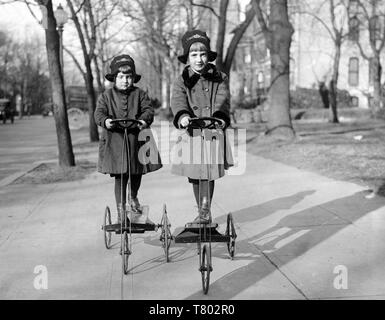 Three-Wheeler Scooters, 1910s Stock Photohttps://www.alamy.com/licenses-and-pricing/?v=1https://www.alamy.com/three-wheeler-scooters-1910s-image245864612.html
Three-Wheeler Scooters, 1910s Stock Photohttps://www.alamy.com/licenses-and-pricing/?v=1https://www.alamy.com/three-wheeler-scooters-1910s-image245864612.htmlRMT802R0–Three-Wheeler Scooters, 1910s
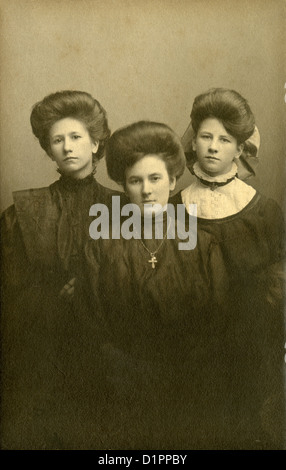 Circa 1880s photograph, three Victorian sisters from Holyoke, Massachusetts, USA. Stock Photohttps://www.alamy.com/licenses-and-pricing/?v=1https://www.alamy.com/stock-photo-circa-1880s-photograph-three-victorian-sisters-from-holyoke-massachusetts-52746287.html
Circa 1880s photograph, three Victorian sisters from Holyoke, Massachusetts, USA. Stock Photohttps://www.alamy.com/licenses-and-pricing/?v=1https://www.alamy.com/stock-photo-circa-1880s-photograph-three-victorian-sisters-from-holyoke-massachusetts-52746287.htmlRMD1PPBY–Circa 1880s photograph, three Victorian sisters from Holyoke, Massachusetts, USA.